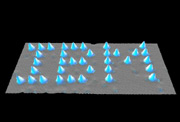Scientists learn to recognize a new way of changing materials at the atomic level
Mark Peplow, Nature

Don Eagler's atomic graffiti
Direct address to this page:
https://www.hayadan.org.il/stmcharge0704.html
Ever since Don Eigler spelled out the letters IBM using 35 xenon atoms in 1989, researchers in the field of nanotechnology have sought to improve their control over the building blocks of matter.
Now this control has reached a new level. Instead of moving individual atoms, IBM scientists say, they can change the electric charge of atoms by controlling individual electrons.
"People have been moving seals for ten years. Here we went one step further by leaving the atoms in place, but changing their state," says Carsten Horn, a physicist at the Fritz Haber Institute of the Max Planck Society in Berlin, Germany.
The electric charge of an atom is one of its most fundamental properties. It affects the way it reacts to the world and the way its electricity is transmitted to its neighboring atoms.
Jessica Repp, a physicist at the IBM Zurich Research Laboratory in Switzerland, and his team used a Scanning Tunneling Microscope to add a single electron to individual gold atoms. The process charged each of the atoms with a negative electric charge. A scanning tunneling microscope, invented in the 1980s, consists of a tip, the size of which at the tip is on the order of an atom or a few individual atoms. When the microscope scans an area, atoms change the electric current that passes through the tip.
Scientists often use this information to build a three-dimensional map of the atomic hills and valleys of the surface of a piece of material. Rapp's research, published in this week's issue of the journal Science, proves, however, that the tip of the microscope can be used to move electrons from atoms across the surface of the material with great precision. In addition, the microscope can pass once more over the gold atoms and sense whether they are negatively charged or neutral.
Rapp's team plans to use the technique to test useful electrical properties among new materials. "In the long term, we are looking for alternatives to conventional semiconductors," says ref. "Electronics on the order of atoms gives you components 10,000 times smaller, which generate much less heat."
He adds that a string of neutral and negatively charged gold atoms could theoretically store information, similar to the series of "0" and "1" switches that form the basis of binary computing. However, Rep admits that such a device is decades away from realization.
Don Eagler's 1989 creation of nanoart was a defining moment in the emerging science of nanotechnology. She proved that applying voltage to the tip of a scanning tunneling microscope can turn the microscope into atomic tweezers.
At that time Eagler was only able to make his atoms remain still at a temperature of -269 degrees Celsius, only four degrees above absolute zero, the lowest possible temperature. At higher temperatures the thermal energy of the atoms caused them to leave the surface.
However, Eggler's experiment laid the foundations for changing molecules at room temperature, a result that was achieved several years later. Rapp carried out his experiments at a temperature of about minus 269 degrees Celsius, but he hopes that advances in charging atoms will heat things up quickly.
"There is a huge potential for science here. "Many scientists will read this paper and rush to try the experiments themselves," Horn said.
Translation: Dikla Oren
The article in Nature
Physics expert
https://www.hayadan.org.il/BuildaGate4/general2/data_card.php?Cat=~~~906257481~~~57&SiteName=hayadan
